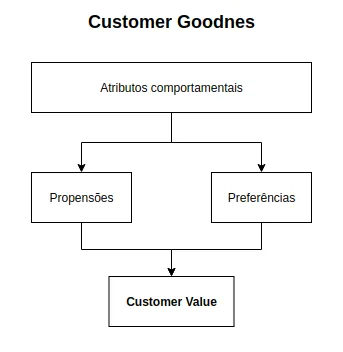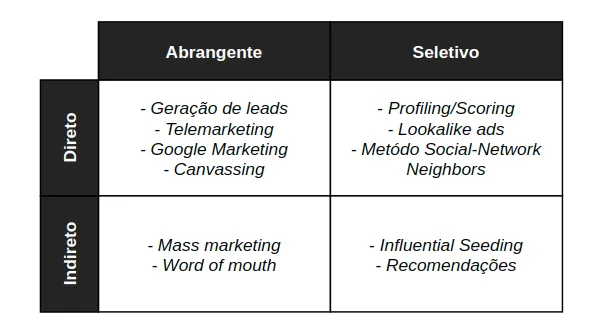Erick Costa de Farias
💻 Data & AI Manager on iFood
Over the last few months I have been involved in a Data Science for CRM. Although the ultimate goal of the project is automate the CRM flow and apply Reinforcement Learning in the selection of strategies for each client ( I hope to still write about this case!) , I took the opportunity to invest time to resurrect some old and new marketing references and ensure domain knowledge — which is essential for any successful Data project.
I decided to summarize the main ideas, mainly so that other Data Analysts and Data Scientists involved in Marketing projects have a good understanding primer in CRM.
What is CRM?
As its name suggests, Customer Relationship Management (CRM) is a management system for all interactions with your customers.
Some literature focuses more on the aspect technological a CRM system; others, more in the strategic aspect.
Instead of thinking about a pocket definition, I believe it is more useful to consider the main elements of a well-executed CRM system, which needs to be reflected in both the strategic definition and the choice of technological tools to improve it.
Customer Focus
What do you know about your customer?
Recently, the expression customer centric became another keyword used thoughtlessly in business meetings.
Most of the time I heard people talking about the client , it was as if this were an entity, a kind of substantial mass that responds in a certain way to the product and whose only thing that interests me is a certain characteristic average.
Well, one of the gurus of theories of customer centricity, Peter Fader, slavishly says that approaching the client that way is an antiquated and most likely sub-optimal way. This is very common in product-focused strategies, which spend precious resources seeking to achieve sales targets for anyone, at any cost, ignoring the heterogeneity of their current and potential customer base.
Have a customer-focused CRM strategy ( customer centric) means, first and foremost, celebrating the diversity of its users — consider that different people react in different ways to your product and its relational approaches and dive into the search to understand the characteristics of those who react positively (or not).
I.e , different customers have different characteristics that reflect the value that this relationship has for the business.
The first mistake I have no idea what this is value , which is called Customer Lifetime Value (CLV).
The second mistake is having no idea which behavioral attributes have any impact on this value.
Making these two mistakes is the right step for blind CRM strategies that shoot in the dark hoping to hit an unprepared customer (an example of the consequence of this is spending resources on retention strategies on users who have a very low propensity to leave).
This means that if you don't have a consolidated CLV metric being used to drive your CRM strategies, you are far from customer-centric.
To address the issue ( More on this in part II of this series ), CLV is basically an estimate of the present value of profit directed at a customer's relationship with your business. By nature, this is a measure predictive (and because of this, some references make a point of naming him ECLV — Expected Customer Lifetime Value) . Although there are several ways (simpler and more complex) to structure these estimates, a CLV metric that does not project The value of each customer's relationship is, at best, enviable. In other words, she must consider:
- How long did this relationship last (for customers who left) or how long possibly will last (for current and future customers);
- The number of transactions;
- The value of these transactions;
- Other non-financial activities in which the customer may be involved (recommendations of your product, reviews on social media, etc.).
Fader proposes a CLV metric as the primary measure of customer quality — which defines how good your customer is for the business.
Customer kindness is an umbrella concept to encapsulate the value of a customer, which can be broken down into other factors such as propensities and preferences.
What this means, for example, is that there are different proposals that can lead to a higher CLV, such as propensity to repeat a purchase , or the propensity to make purchases of high monetary value , The propensity to leave Or the preference to make purchases through a specific channel , which may have a lower cost. A truly customer-focused organization seeks to understand what attributes characterize those propensities and preferences that make up a customer's value, and dedicate itself to making them as actionable as possible.
This way, I can create a specific campaign to direct my customers from channel A to B, reducing costs and increasing their CLV; or another campaign to increase the reproduction propensity to purchase, and so on. In general, the execution of tactical actions aims to turn the needle on some propensity or preference, which in turn impacts each customer's CLV.

These well-defined intermediate factors in your CLV metric are extremely relevant. This will help create different strategies for customers at the same value level, given that a customer with a high propensity to reward, for example, may have a low propensity to spend. It would be at least shortsighted on board in the same way.
And this is where I believe data time has a huge value. Generally, these proposals and preferences, as well as the CLV itself, depend on analysis and modeling, however simple they may be.
Ultimately, a well-executed CRM strategy should reflect on these issues and, ideally, support the identification of high-value customers and an understanding of the factors that impact this value. From this, it is possible to create acquisition, retention and development initiatives, which are the 3 main tactical keys in maximizing the value of your customer base.
Acquisition Strategies
Fader insists that an organization often has more control over the type of clients that are brought in compared to trying to change and “improve” those that are already active.
The idea here is simple — when a customer is brought into your active base, they are “born” with a kind of baseline in their good customer. She has a certain configuration of propensities and preferences that form her potential . Some of these propensities and preferences can be changed more easily, others cannot.
An organization can spend years trying to increase the average frequency of its user base in a sustainable way (more on this in the next section) without having much success.
But speaking of acquisition, The primary objective here is to catch the best customers — that is, those who have a high baseline of customer kindness .
The problem is that most of the time marketing and sales don't look at this. You dashboards with acquisition metrics bring aggregated numbers of conversion and cost per acquisition (CPA), as if the “Customer” were that single entity, the surrounding mass that organizations centered on extravagant products. And the big mistake is not having any idea where the highest-value customers' achievements come from and what they are like.
In general, acquisition tactics are divided into integral or selective, direct or indirect. Most companies use an approach to blending, where investment in acquisition is divided into different fronts. The secret here is to carry out a tracking of the value of the different customers acquired by each strategy over time and optimize the investment allocated to each of them.
Comprehensive initiatives
An initiative embracing It's like casting a fishing net into a lake. It comes from everything, even tires.
But this is not necessarily a bad thing, being an important part of new business acquisition or product launch strategies where the aim is to fill the sales pipeline, justify demand and stimulate sales effects. network. Businesses that have a low-play purchasing nature can also benefit from more comprehensive acquisition strategies.
Initiatives comprehensive-direct are used when you know who it's yours prospects, but he doesn't know much beyond that. Possibly, you have a list of names, emails and telephone numbers, period. Common approach channels in this category include telemarketing and Google Marketing, for example.
Initiatives comprehensive-indirect are used when you don't know who your potential client . The good old mass marketing enter here. This category includes TV ads, billboards, in-app ads, sponsorship activities.
Selective initiatives
The initiatives selected They tend to be more expensive and make more sense when there are capacity constraints (not offering a product or service) or when switching costs are high, for example.
Initiatives direct selective are possibly the most elaborate. There is usually a profile template used to identify the highest value customers (which may use demographics, product interactions, etc.). So lists of prospects are used, and scoring models are created to determine which prospects seem closer to this high-value customer profile. Popular channels in this category include a lookalike audiences offered by Facebook or other platforms advertising.
For those new to Data Science, a study published by Provost et al shows that using social connection data and graph modeling can greatly help in optimizing acquisition strategies. New customers socially linked to other people who were already customers tend to adopt the product 3 to 5 times more than base groups selected by characteristics of the product models. profile.
In initiatives selective-indirect, Organizations look for new customers who have something in common with their high-value customers, without necessarily knowing who they are. Classic examples are the strategies of social seeding it's from member get member , where an active customer receives an incentive to recommend the product or service.
Recommendation ( reference) is a very important thing because (1) it says something important about the customer you referred, (2) it usually has a much lower CPA, and (3) referred customers tend to have higher levels of customer kindness.

Some comments:
- Specific information about customers and prospects are increasingly easier to collect, analyze and store. This should reflect more direct acquisition strategies, which tend to “generate” customers with a higher baseline of customer kindness ;
- Think of acquisition strategies like an investment portfolio — the more you focus on finding the best customers, the more you need from the not-so-good ones, as if you literally need to spread the risk across your customer base;
- Customers with high kindness they are scarce and finite — the more you explore the same acquisition channel, the value of customers coming from there tends to decrease;
A short story about acquisition addiction
Why does the value of my customers matter if we are hitting sales targets?
Well, one short answer is that organizations that rely on unhealthy customer acquisition will have problems in terms of long-term economic options. In 2017, for example, professor Dan McCarthy from Emory University , published a study of customer-based corporate assessment ( CBCV) and declared that a company called Overstock and Wayfair lost around US$ 10 for each new customer acquired. Because of this, its share price was overestimated by approximately 84%. Imagine what happened to the stock market a few hours after the study was published? So it is.
Retention and Development Strategies
Guarantee the loyalty of your best customers is a basic principle in a CRM strategy customer-centric . 80% of your profits will come from 20% of your customer base (which is why you need to know who they are!).
But as we mentioned in the statements above, your customers are “born” with a baseline of propensities to stay or leave, repeat a purchase, and spend more or less on your products and services. In practice, this means that it is It's very difficult to change a zebra's stripes. Therefore, when creating development tactics, you need to be aligned about expectations — while it is possible, it is unlikely that a low-value customer will become a customer. top-tier in terms of CLV.
R&D strategies generally fall into 4: cross-selling, up-selling, loyalty and customer service programs.
Cross-selling: Is it fries?
Your active, high-value customers are much more likely to try new products and services than your low-value customers. It is important that you invest in cross-selling mainly for customers mid It is top-tier. Here, recommendation algorithms tend to be excellent. Generally, the implementation of recommendation engines is not obstructive to the shopping experience and is highly customizable for each customer — something essential in a strategy customer-centric.
Up-selling: Do you want the giant version for more $0.99?
Persuading a customer to increase the value of their order is a classic example of up-selling . Another example of a tactic in this category is offering premium services (consider the Linkedin Premium or Amazon Prime, for example). The great idea of these services is to turn non-contractual customers into contractual ones, increasing the propensity for repeat purchases and expenses per order or time spent on the platform, for example. It's a great way to increase your customer quality from an already good customer.
The idea is simple, but the secret is subtle. A study summarized in a 2012 HBR article, commenting on the side B of cross-selling , concludes that:
1 in 5 customers who cross-purchase are unprofitable. This group represents, on average, 70% of the total loss of a customer base — the deficit when the cost of offering products or services is greater than a customer's revenue. In these cases, the more cross-purchases a customer makes, the greater the loss.
Considering this harsh reality, Fader proposes a simple framework for compensating R&D strategies. It basically consists of (1) segmenting your users into CLV levels (bronze, silver, gold, etc. be creative! ); (2) create different strategies for each level, which may have additional breaks based on propensities and preferences (high CLV level, low/high CLV propensity turnover, for example); (3) in each of these strategies, define which tactics aggressive and/or defensive will be renewed.

While the primary goal of defensive tactics is to increase the propensity of customers to repeat purchases and spend more, defensive tactics reduce the propensity of go away, things usually get mixed up (and that's ok). But it is important that initiatives have their analyzes and objectives well defined.
Offensive tactics
The simple “ Buy 9, get 1 ”, or its more sophisticated and gamified versions are examples of loyalty programs . A classic way to extract a little more value from a customer more or less in terms of CLV. As a good example, the Starbucks ran a loyalty program that extended loyalty into a tangible, convenient service that also leveraged its customer data acquisition. But this program is unlikely to transform customers from intermediate level (in terms of CLV) in level customers higher. And this is the biggest shortcoming of loyalty programs: Incremental incentives are generally not persuasive for heavy users and possibly result in high cannibalization (you are offering a free drink to someone who would probably already buy another).
Therefore, the best way to increase the well-being of its top-tier customers is to offer services premium. The idea here is simple: your high CLV customers already like you. They don't want to be bothered, but they would probably see value in some kind of premium service you could offer. A good example of this is the LinkedIn Premium , which turned non-contractual customers into contractual ones, and represented around 20% of Linkedin's revenue just before it was purchased by Microsoft.
Defensive tactics
To state the obvious, it is important that the propensity of your customers to leave first line remain at low levels. A sure way to reduce this propensity is to ensure a relationship of trust and interdependence between the organization and its most important customers — making them feel valued through personalized customer service and creative solutions for its main customers. trouble spots. Usually called Strategic Account Management or Customer Success Management , project management on this tactical front, although it has a potential positive impact on repeat purchase propensities and average spend, should have as its primary objective the maintenance of long-term value through shielding rather than opportunistic value creation that can be viewed suspiciously (and even backfiring).
The same idea is reflected in the defensive tactic for customers low level , with the only difference that execution needs to be done at scale, with low costs and in a more reactive than proactive way. Fader comments that a customer service responsive and reliable has an essential role in retention strategies, in addition to being a constant source of insights for product improvement.
An analogy is that a good customer service is like having clean bathrooms — your customers are more comfortable visiting them, but that's not a way to dramatically grow your business. And the idea of this phrase is really provocative, since Fader argues that great promises of growth based on investments in Customer Experience (CX) are not profitable.
. . .
In the next texts, I will write about frameworks for evaluating and monitoring CRM strategies and some suggestions for Machine Learning models that can be used to optimize these strategies!
References
Fader, P. Toms, S. “ The Customer Centricity Playbook”, Wharton School Press (2019)
Farris, P. et al “ Marketing Metrics”, Pearson (2016)
Pfeifer, Phillip E., Mark E. Haskins, and Robert M. Conroy (2005), “Customer Lifetime Value, Customer Profitability, and the Treatment of Acquisition Spend,” Journal of Managerial Issues
Pfeifer, Phillip E., Mark E. Haskins, and Robert M. Conroy (2005), “Customer Lifetime Value, Customer Profitability, and the Treatment of Acquisition Spending”, Journal of Managerial Issues,


